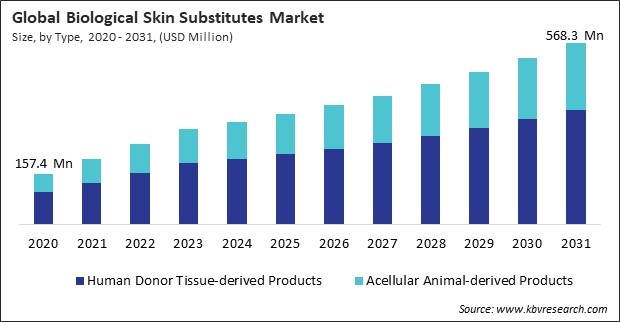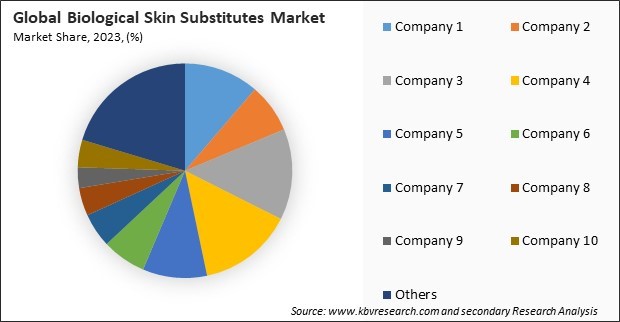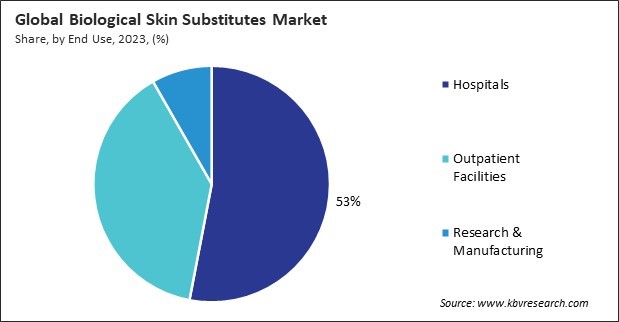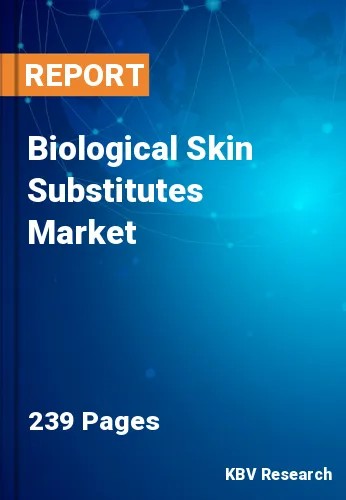“Global Biological Skin Substitutes Market to reach a market value of 568.3 Million by 2031 growing at a CAGR of 8.6%”
The Global Biological Skin Substitutes Market size is expected to reach $568.3 Million by 2031, rising at a market growth of 8.6% CAGR during the forecast period.
The North American market for biological skin substitutes leads globally, propelled by advanced healthcare infrastructure, significant investment in R&D, and a high prevalence of chronic wounds and burn injuries. Additionally, rising awareness about advanced wound care therapies and the continuous introduction of innovative products contribute to the segment's growth, making North America the dominant region for biological skin substitutes. Thus, the North America segment procured 40% revenue share in the biological skin substitutes market in 2023.

Chronic wounds, such as diabetic foot ulcers, venous leg ulcers, and pressure ulcers, are often challenging to heal due to underlying health conditions like diabetes, poor circulation, and prolonged immobility. It is anticipated that 1 to 2 percent of the population in developed countries will endure a chronic wound at some point in their lives. Additionally, Reconstructive surgeries, often performed after trauma, burn injuries, cancer treatments, or congenital disabilities, also drive the demand for biological skin substitutes. Many patients undergoing reconstructive surgery require skin grafts to restore skin loss due to injury or illness, and biological substitutes offer an effective solution by promoting natural healing and minimizing visible scarring. Reconstructive surgeries, often performed after trauma, burn injuries, cancer treatments, or congenital disabilities, also drive the demand for biological skin substitutes. Many patients undergoing reconstructive surgery require skin grafts to restore skin loss due to injury or illness, and biological substitutes offer an effective solution by promoting natural healing and minimizing visible scarring.
However, biological skin substitutes significantly advance wound care and skin regeneration, providing a promising solution for burn victims and individuals with chronic wounds. However, one of the primary barriers to their widespread adoption is the high cost associated with these products. Developing biological skin substitutes requires sophisticated, cost-intensive manufacturing processes, including the harvesting, processing, and preserving of human or animal-derived tissues. Hence, the high cost of biological skin substitutes restricts their accessibility, limiting their impact on global health outcomes in wound care and skin regeneration.

The leading players in the market are competing with diverse innovative offerings to remain competitive in the market. The above illustration shows the percentage of revenue shared by some of the leading companies in the market. The leading players of the market are adopting various strategies in order to cater demand coming from the different industries. The key developmental strategies in the market are Acquisitions, and Partnerships & Collaborations.
Based on type, the market is bifurcated into human donor tissue-derived products and acellular animal-derived products. The human donor tissue-derived products segment garnered 64% revenue share in the market in 2023. This segment leads the market due to its high compatibility and acceptance rates within the human body, which results in improved healing outcomes.
On the basis of end use, the market is classified into hospitals, outpatient facilities, and research & manufacturing. The hospitals segment acquired 53% revenue share in the market in 2023. This prominence is attributed to hospitals' comprehensive infrastructure and specialized medical personnel, enabling them to effectively manage complex wound care cases.

By application, the market is divided into acute wounds and chronic wounds. The chronic wounds segment garnered 47% revenue share in the market in 2023. These wounds are often challenging to heal and require long-term management strategies. Biological skin substitutes offer effective solutions by providing a conducive environment for tissue regeneration and reducing healing time.
Free Valuable Insights: Global Biological Skin Substitutes Market size to reach USD 568.3 Million by 2031
Region-wise, the market is analyzed across North America, Europe, Asia Pacific, and LAMEA. The Europe segment acquired 30% revenue share in the market in 2023. The European market is driven by increasing awareness of advanced wound care solutions, a growing elderly population susceptible to chronic wounds, and proactive government initiatives supporting healthcare advancements.
| Report Attribute | Details |
|---|---|
| Market size value in 2023 | USD 298.1 Million |
| Market size forecast in 2031 | USD 568.3 Million |
| Base Year | 2023 |
| Historical Period | 2020 to 2022 |
| Forecast Period | 2024 to 2031 |
| Revenue Growth Rate | CAGR of 8.6% from 2024 to 2031 |
| Number of Pages | 239 |
| Number of Tables | 330 |
| Report coverage | Market Trends, Revenue Estimation and Forecast, Segmentation Analysis, Regional and Country Breakdown, Market Share Analysis, Porter’s 5 Forces Analysis, Company Profiling, Companies Strategic Developments, SWOT Analysis, Winning Imperatives |
| Segments covered | Type, End Use, Application, Region |
| Country scope |
|
| Companies Included | Smith & Nephew plc, Stryker Corporation, MIMEDX Group, Inc., Organogenesis Holdings, Inc., Integra LifeSciences Corporation, 3M Company, Essity AB (BSN Medical), Zimmer Biomet Holdings, Inc., Vericel Corporation and Molnlycke Health Care AB |
By Type
By End Use
By Application
By Geography
This Market size is expected to reach $568.3 Million by 2031.
Increasing incidence of chronic wounds and burns are driving the Market in coming years, however, High cost associated with biological skin substitutes restraints the growth of the Market.
Smith & Nephew plc, Stryker Corporation, MIMEDX Group, Inc., Organogenesis Holdings, Inc., Integra LifeSciences Corporation, 3M Company, Essity AB (BSN Medical), Zimmer Biomet Holdings, Inc., Vericel Corporation and Molnlycke Health Care AB
The expected CAGR of this Market is 8.6% from 2024 to 2031.
The Acute Wounds segment is leading the Market by Application in 2023; thereby, achieving a market value of $294.3 million by 2031.
The North America region dominated the Market by Region in 2023, and would continue to be a dominant market till 2031; thereby, achieving a market value of $220.4 million by 2031.
Our team of dedicated experts can provide you with attractive expansion opportunities for your business.

 Drivers
Drivers
 Restraints
Restraints
 Opportunities
Opportunities
 Challenges
Challenges
